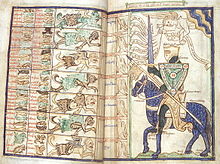Seven deadly sins
set of vices in Christian theology and Western philosophy
The Seven deadly sins, also known as the capital vices, or cardinal sins, is a grouping and classification of vices within Christian teachings. According to the standard list, they are pride, greed, wrath, envy, lust, gluttony, and sloth.

| This Christianity-related article is a stub. You can help out with Wikiquote by expanding it! |
Quotes
edit- Since the work of Zielinski and Gothein in the early years of this century, it has been clear that the medieval and modern Catholic teaching of the seven cardinal sins, sometimes called the deadly sins, had a Hellenistic astrological origin. The details of that provenance, however, are still vague, and it is my purpose to add some further information tending to clarify the complex problems of origins.
- The deadly sins were those sins which the rabbis and early Church Fathers felt led to damnation. They are usually based on the ten commandments. There are numerous references to them in Jewish and Christian writings of the age...
- Morton W. Bloomfield, references The Origin of the Concept of the Seven Cardinal Sins, Harvard Theological Review], (April 1941)
- The Church was not completely successful in purging the seven cardinal sins of their astrological origin, for surprisingly enough, beginning in the fourteenth century, the planets are linked to the sins more distinctly than ever before in Christian literature. In fact, the best examples come from this time. Where the association existed in the interval, unless it be an accidental rewelding or in Arabic astrological lore, I cannot guess.
- Morton W. Bloomfield, references The Origin of the Concept of the Seven Cardinal Sins, Harvard Theological Review], (April 1941)
- “Are you familiar with Wallader’s theory that every society is fundamentally organized around one or another of the cardinal sins?”
“I believe not,” I said.
“He argues that the true seed of every culture, whatever the ideals to which it gives lip service, always turns out to be one of the seven mortal iniquities identified by the ancients: pride, greed, and anger are the most common; lust, gluttony, and envy less so; those based on sloth usually do not last.”- Matthew Hughes, Hespira (2009), ISBN 978-1-59780-101-0, p. 70
- The early Christians also extolled torture as just deserts for the sinful. Most people have heard of the seven deadly sins, standardized by Pope Gregory I in 590 CE. Fewer people know about the punishment in hell that was reserved for those who commit them: "Pride: Broken on the wheel. Envy: Put in freezing water. Gluttony: Force-fed rats, toads, and snakes. Lust: Smothered in fire and brimstone. Anger: Dismembered alive. Greed: Put in cauldrons of boiling oil. Sloth: Thrown in snake pits." The duration of these sentences, of course, was infinite. By sanctifying cruelty, early Christianity set a precedent for more than a millennium of systematic torture in Christian Europe. If you understand the expressions to burn at the stake, to hold his feet to the fire, to break a butterfly on the wheel, to be racked with pain, to be drawn and quartered, to disembowel, to flay, to press, the thumbscrew, the garrote, a slow burn, and the iron maiden (a hollow hinged statue lined with nails, later taken as the name of a heavy-metal rock band), you are familiar with a fraction of the ways that heretics were brutalized during the Middle Ages and early modern period.
- Steven Pinker, The Better Angels of Our Nature (2012)
- The concept of sin is a hard sell to atheists and agnostics alike. But... the seven deadly sins—has entered the collective consciousness regardless of belief. The origins of the seven deadly sins are nebulous and likely trace back to before Hellenistic Greece. The traditional seven deadly sins—as portrayed in Dante’s Inferno and Chaucer’s Canterbury Tales—include pride, envy, anger, sloth, greed, gluttony, and lust. Although this list has gone through various iterations in Christian liturgy, its foundations are more archetype than religious history... In the Old Testament, seven spirits of deceit are mentioned including fornication, gluttony, fighting, vain-glory, pride, lying, and injustice. This list likely influenced Evagrius Ponticus to write about the following eight categories of evil thoughts: gluttony, lust, greed, sorrow, wrath, pride, vain-glory, and sloth.... Notably, the reason why these sins are “deadly” (and not merely damaging) is rooted in Christianity. They are deadly because they have the power to “maim” or “kill” the divine spirit present in all men and women.
- Naveed Saleh in Where Did the 7 Deadly Sins Come From? Which sin is the worst? No wrong answers, Psychology Today (16 Feb 2020)
See also
edit|
|